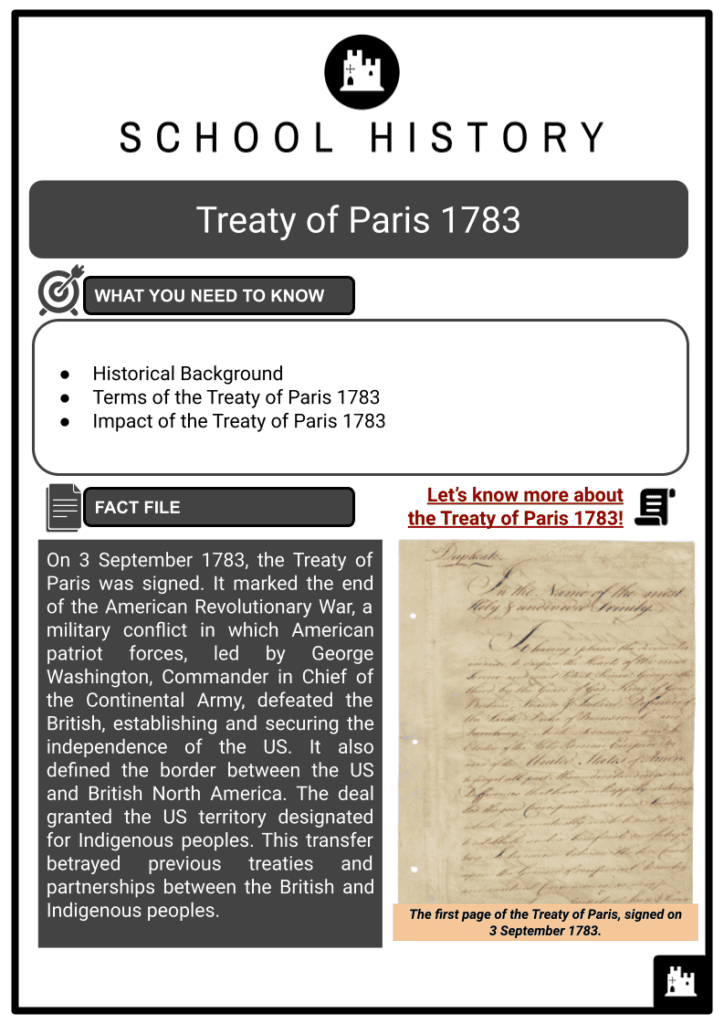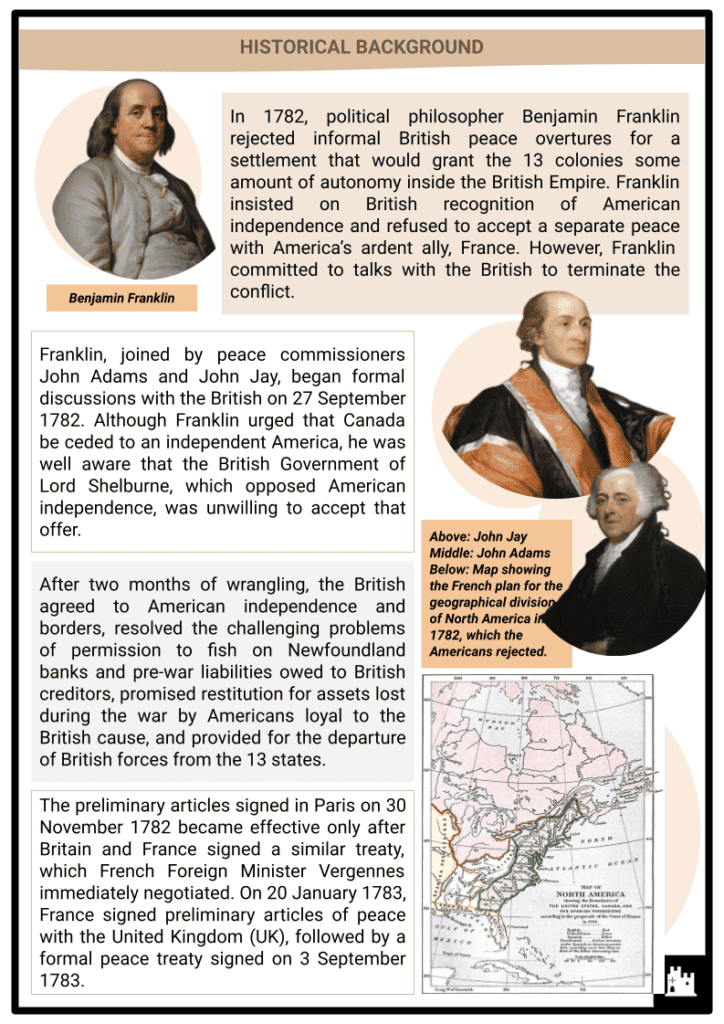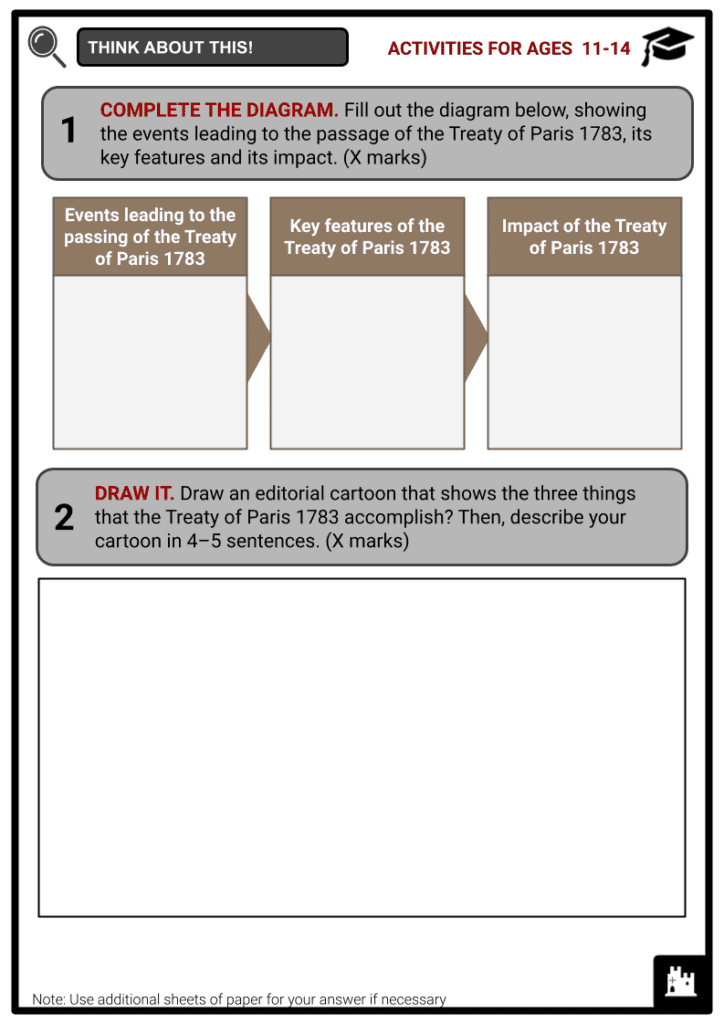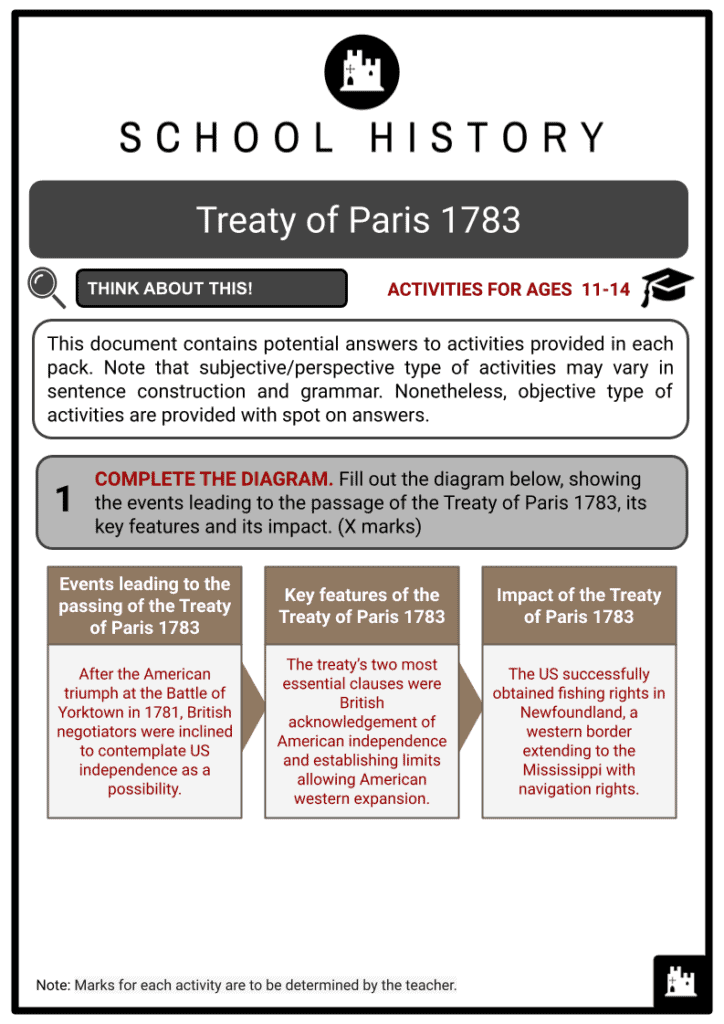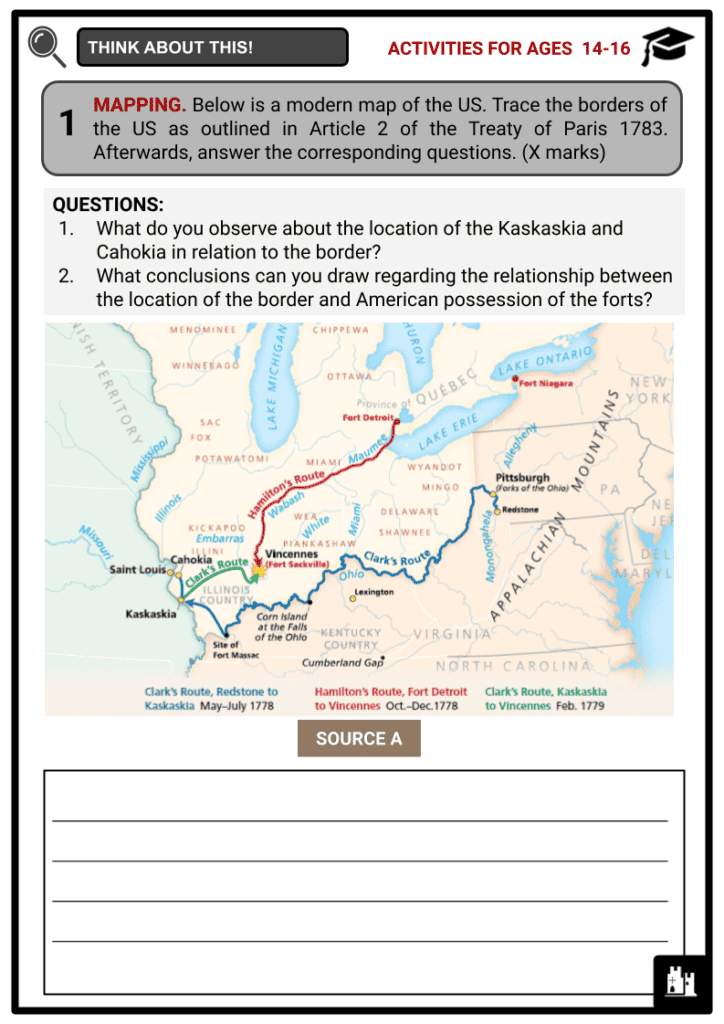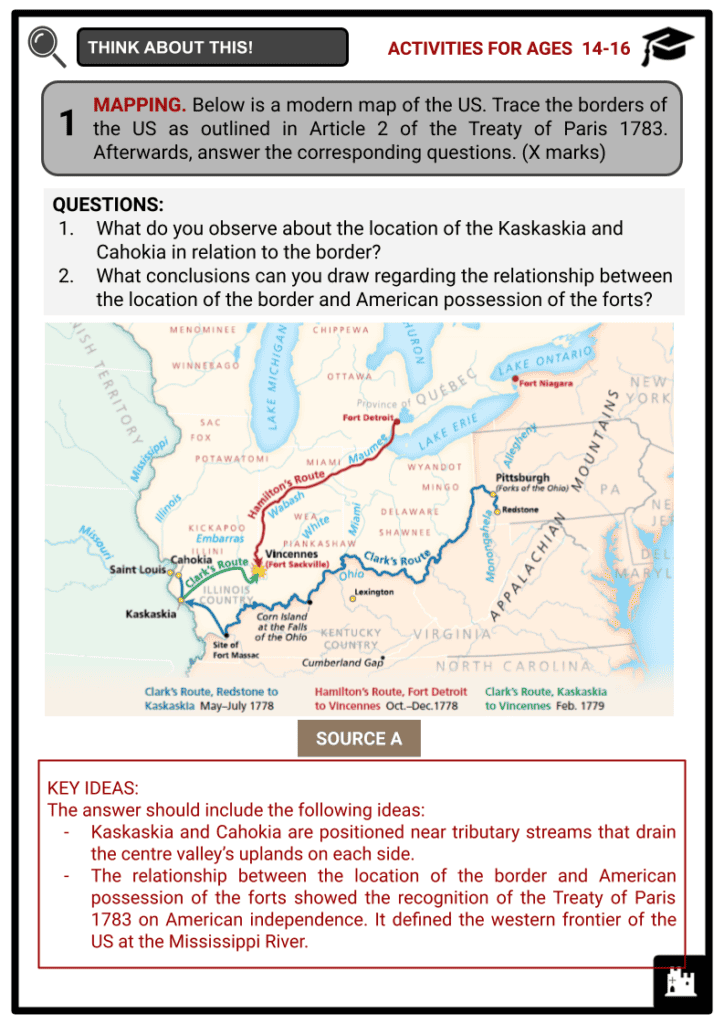Treaty of Paris 1783 Worksheets
Do you want to save dozens of hours in time? Get your evenings and weekends back? Be able to teach about the Treaty of Paris 1783 to your students?
Our worksheet bundle includes a fact file and printable worksheets and student activities. Perfect for both the classroom and homeschooling!
Summary
- Historical Background
- Terms of the Treaty of Paris 1783
- Impact of the Treaty of Paris 1783
Key Facts And Information
Let’s know more about the Treaty of Paris 1783!
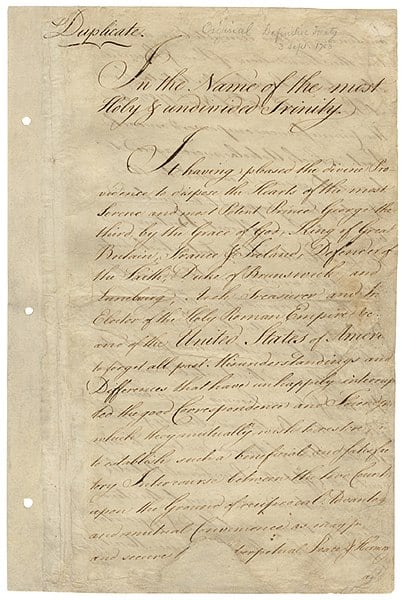
On 3 September 1783, the Treaty of Paris was signed. It marked the end of the American Revolutionary War, a military conflict in which American patriot forces, led by George Washington, Commander in Chief of the Continental Army, defeated the British, establishing and securing the independence of the US. It also defined the border between the US and British North America. The deal granted the US territory designated for Indigenous peoples. This transfer betrayed previous treaties and partnerships between the British and Indigenous peoples.
HISTORICAL BACKGROUND
- In 1782, political philosopher Benjamin Franklin rejected informal British peace overtures for a settlement that would grant the 13 colonies some amount of autonomy inside the British Empire. Franklin insisted on British recognition of American independence and refused to accept a separate peace with America’s ardent ally, France. However, Franklin committed to talks with the British to terminate the conflict.
- Franklin, joined by peace commissioners John Adams and John Jay, began formal discussions with the British on 27 September 1782. Although Franklin urged that Canada be ceded to an independent America, he was well aware that the British Government of Lord Shelburne, which opposed American independence, was unwilling to accept that offer.
- After two months of wrangling, the British agreed to American independence and borders, resolved the challenging problems of permission to fish on Newfoundland banks and pre-war liabilities owed to British creditors, promised restitution for assets lost during the war by Americans loyal to the British cause, and provided for the departure of British forces from the 13 states.
- The preliminary articles signed in Paris on 30 November 1782 became effective only after Britain and France signed a similar treaty, which French Foreign Minister Vergennes immediately negotiated. On 20 January 1783, France signed preliminary articles of peace with the United Kingdom (UK), followed by a formal peace treaty signed on 3 September 1783.
Proposal of Franklin, Jay and Adams
-
- The US controls all lands east of the Appalachian Mountains.
- All lands north of the Ohio River belong to the UK.
- France controls all regions west of the Mississippi River that Spain does not hold.
- A buffer zone between the Appalachian Mountains and the Mississippi River is important to Indigenous peoples.
- Spain would keep control of its southern possessions, including Florida.
- The Congress of the Confederation, the newly-established US legislative body, ratified the Treaty of Paris on 14 January 1784 in Annapolis, Maryland, in the Old Senate Chamber of the Maryland State House, making Annapolis the first peacetime capital of the new US. The capital was later moved to Philadelphia, and then to Washington, D.C. in 1800.
- Copies were returned to Europe for confirmation by the other parties concerned, with the first arriving in France in March 1784. On 9 April 1784, the British ratified the treaty, and the ratified copies were exchanged in Paris on 12 May 1784.
TERMS OF THE TREATY OF PARIS 1783
- The pact and the peace treaties signed by the UK and the three colonial nations that supported the American cause, the Dutch Republic, France and Spain, are known as the Peace of Paris. Only Article 1 of the treaty, which recognises the US as a free, sovereign and independent state, is still in effect.
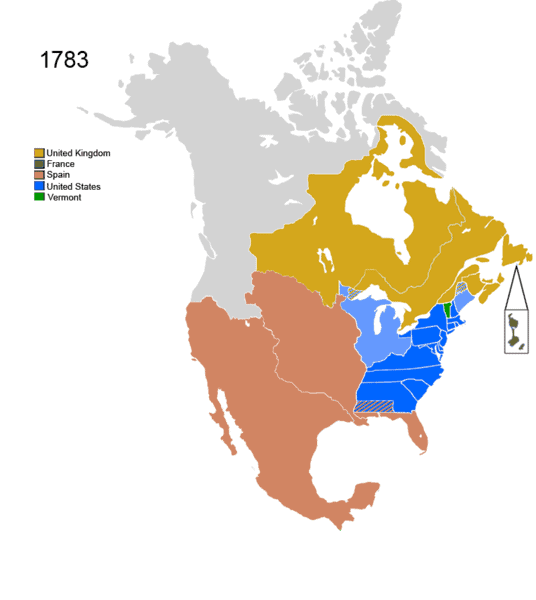
North American map after the Treaty of Paris in 1783 (Vermont was autonomous until 1788). - Specific treaty articles were replaced as the US borders altered in the following years.
PREAMBLE
- Declares the treaty to be “in the Name of the Most Holy and Undivided Trinity,” followed by a reference to Divine providence, and declares both parties’ intention to “forget all past misunderstandings and differences” and “secure to both perpetual peace and harmony.”
SPECIFIC TERMS
- Britain recognises the US as a free, sovereign and independent state, which includes what had been the Connecticut Colony, Colony of Rhode Island and Providence Plantations, Colony of Virginia, Delaware Colony, Massachusetts Bay, Province of Georgia, Province of New Hampshire, Province of Maryland, Province of New Jersey, Province of New York, Province of North Carolina, Province of Pennsylvania, and Province of South Carolina.
- Defining the US borders, which include those between the British North America and US from the Mississippi River to the Southern colonies, Britain relinquishes previously owned land.
- Granting US fishermen fishing rights in the Grand Banks, off the coast of Newfoundland, and in the Gulf of Saint Lawrence.
- Recognising the legally contracted debts owed to creditors on both sides.
- The Confederation Congress would strongly advise state legislatures to recognise the legal owners of all stolen lands and to provide for the recovery of all estates, rights and possessions confiscated from British subjects known as the Loyalists.
- The US will not confiscate Loyalist property in the future.
- Prisoners of war on both sides will be released. All British property in the US will be returned to the British and forfeited. The Mississippi River will be granted to the UK and the US in perpetuity.
- Territories captured after the treaty by either side shall be returned without compensation. The treaty must be ratified within six months of its signing.
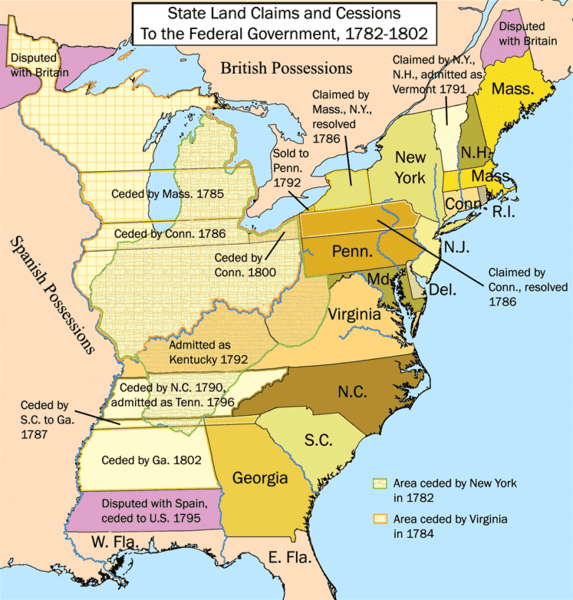
Map of the US and its territories following the signing of the Treaty of Paris.
CLOSING PROTOCOL
- “Done at Paris, this third day of September, in the year of our Lord, one thousand seven hundred and eighty-three.”
IMPACT OF THE TREATY OF PARIS 1783
- Historians have frequently remarked that the pact was extremely favourable to the US regarding considerably expanded borders. Historians such as Alvord, Harlow and Ritcheson have emphasised that British generosity was motivated by a statesmanlike vision of close economic relations between the UK and the US. The concession of the large trans-Appalachian territory was intended to assist American population expansion while also creating profitable markets for British merchants at no military or administrative expense to Britain.
- The idea was that the US would become a key trading partner. As French Foreign Minister Charles Vergennes later said, “the English buy peace rather than make it.” Vermont was included within the boundaries because the state of New York insisted that Vermont be considered a part of New York, even though Vermont was then governed by a government that did not consider Vermont to be a part of the US.
- The actual geography of North America did not correspond to the treaty’s details. The treaty established the southern boundary of the US, but the separate Anglo-Spanish pact did not establish the northern limit of Florida. The Spanish administration assumed the line was the same as in the 1763 agreement that gave Great Britain its first possession in Florida. While the West Florida Controversy raged on, Spain used its newfound sovereignty of Florida to prevent Americans from reaching the Mississippi, violating Article 8.
- The treaty specified that the US border ran directly westwards from the northwesternmost point of Lake of the Woods in present-day Minnesota, Manitoba and Ontario until it reached the Mississippi River. The Mississippi, however, does not stretch that far north, and the line running west from Lake of the Woods never intersects the river. Furthermore, the Treaty of Paris did not specify how the new boundary would control the movement of persons and goods between British North America and the US.
- British forces remained stationed at six forts in the Great Lakes region and two at the north end of Lake Champlain, violating the treaty condition that they would cede control of forts in US territory with all convenient speed. During the Northwest Indian War in 1794, the British also constructed an additional fort in present-day Ohio. The Northwest Indian War was an armed battle between the US and Indigenous peoples over control of the Northwest Territory.
Frequently Asked Questions
- What is the Treaty of Paris of 1783?
The Treaty of Paris was a peace treaty that officially ended the American Revolutionary War between Great Britain and the United States of America in 1783.
- What were the key provisions of the Treaty of Paris of 1783?
The treaty recognised the independence of the United States from British rule. It established the new nation's boundaries, from the Atlantic Ocean to the Mississippi River in the west and from Canada in the north to Florida in the south.
- What country gained the most benefits from the Treaty of Paris?
The United States benefited most from the Treaty of Paris of 1783. It secured its independence, established favourable territorial boundaries, gained fishing rights, received international recognition as a sovereign nation, and even made provisions for reconciliation with loyalists.

